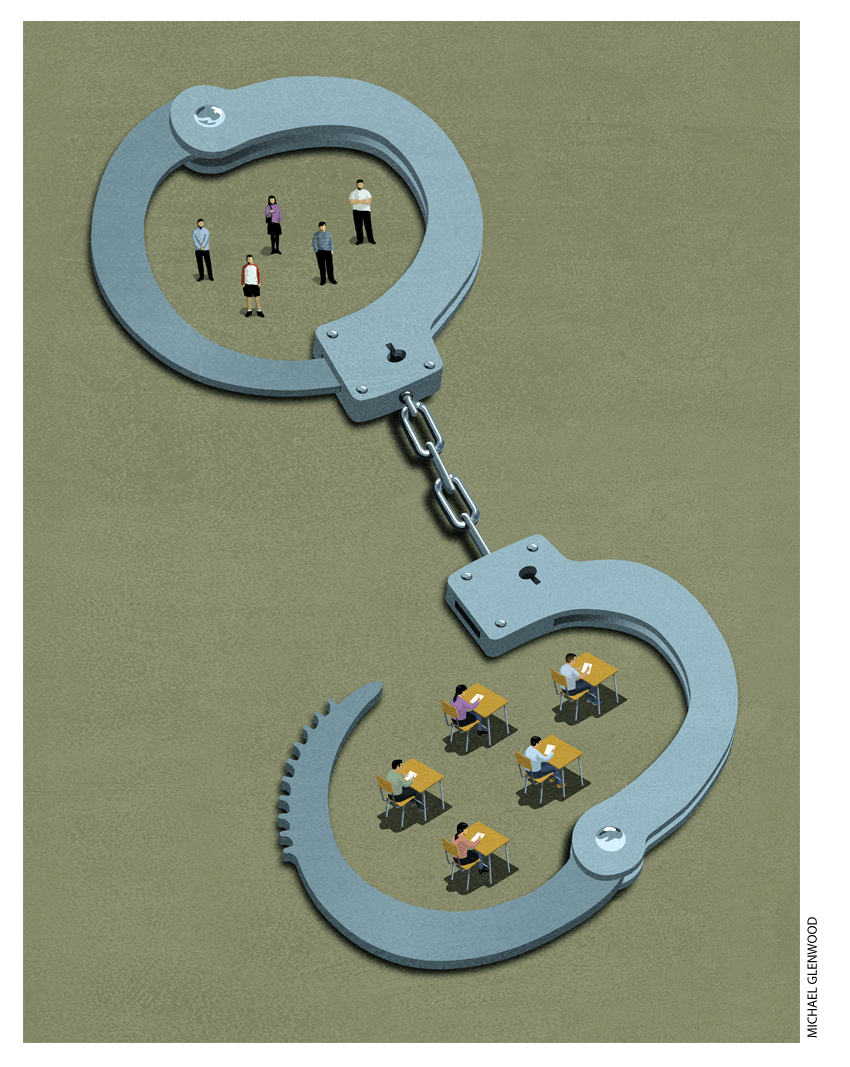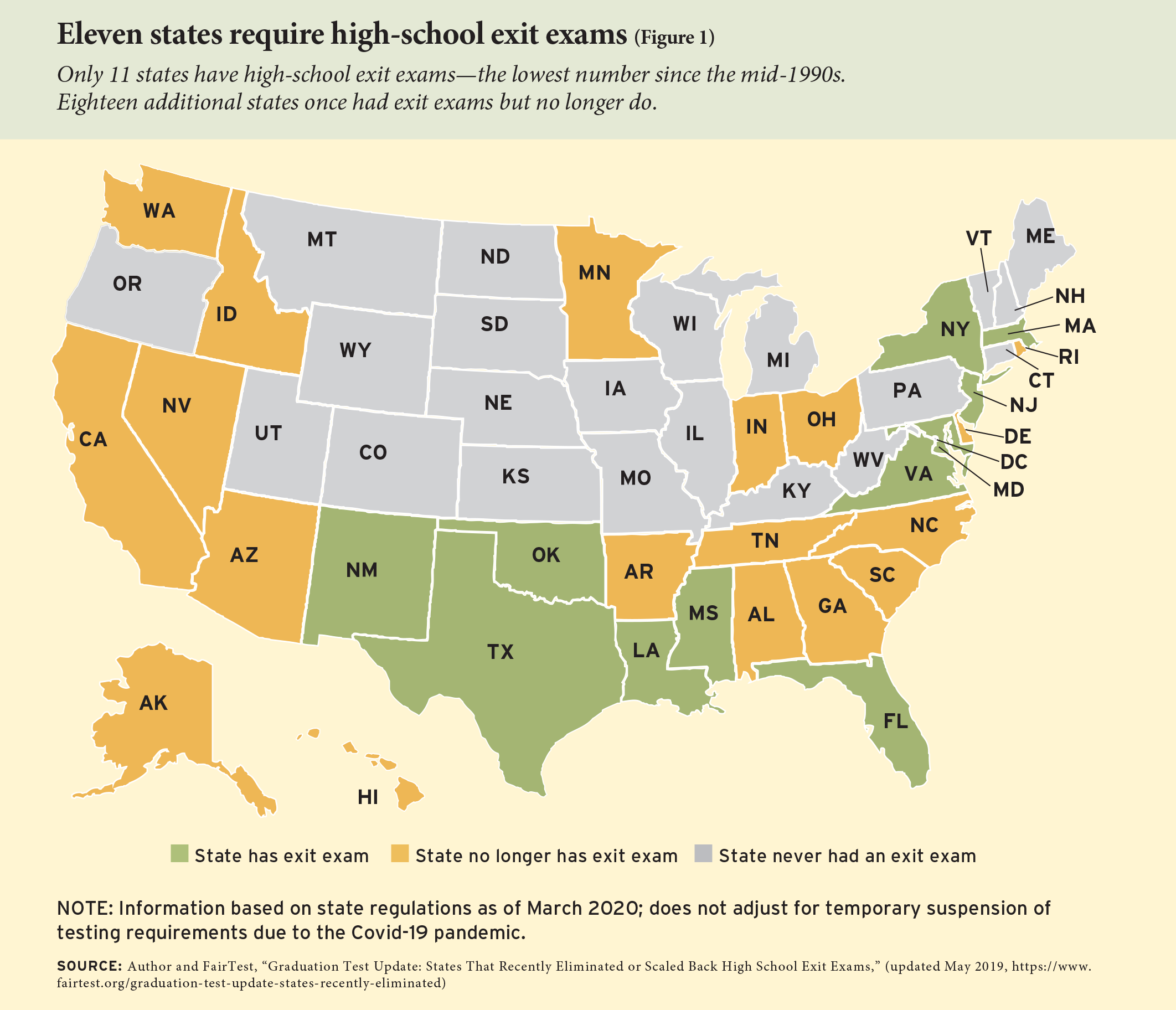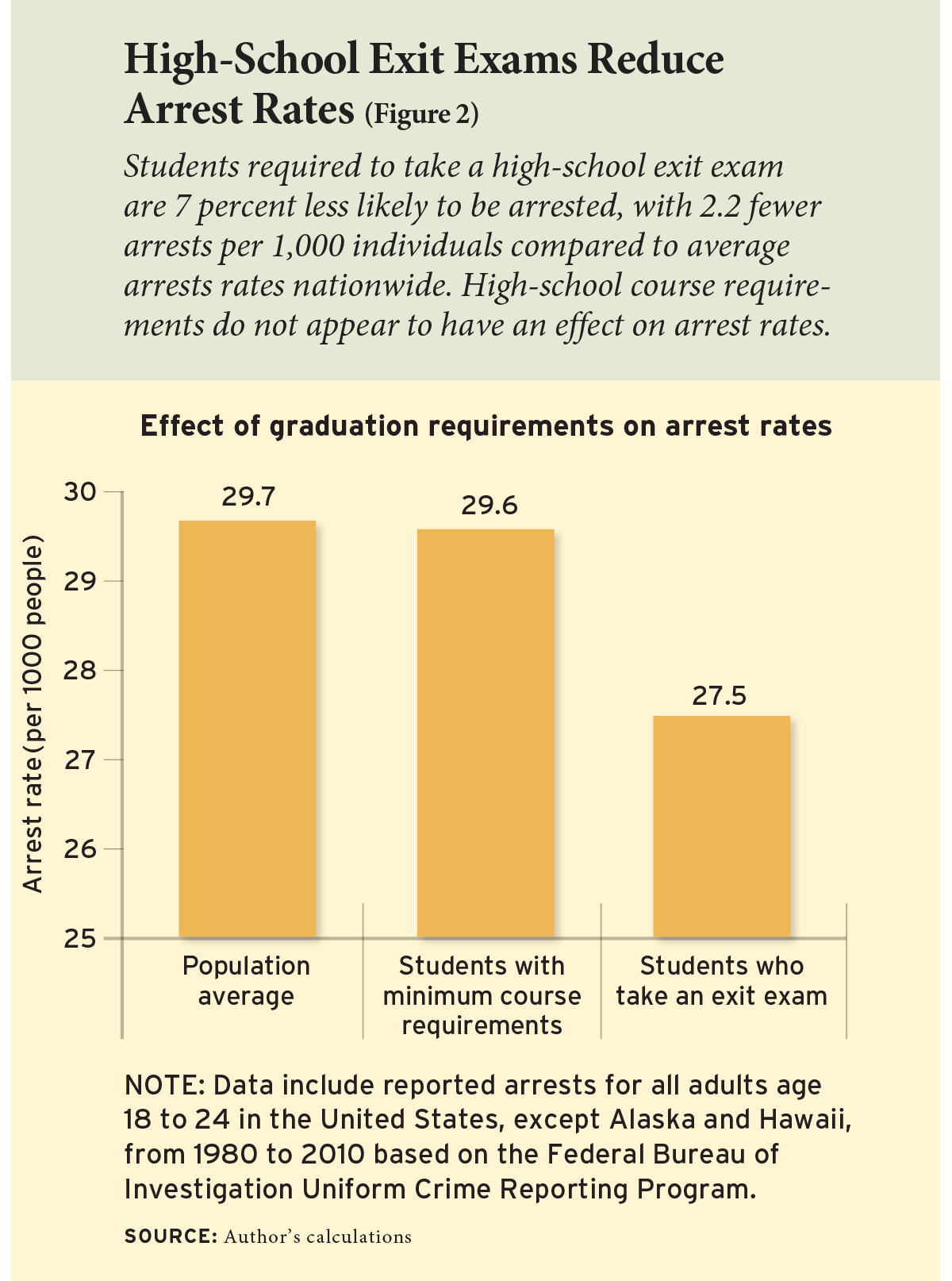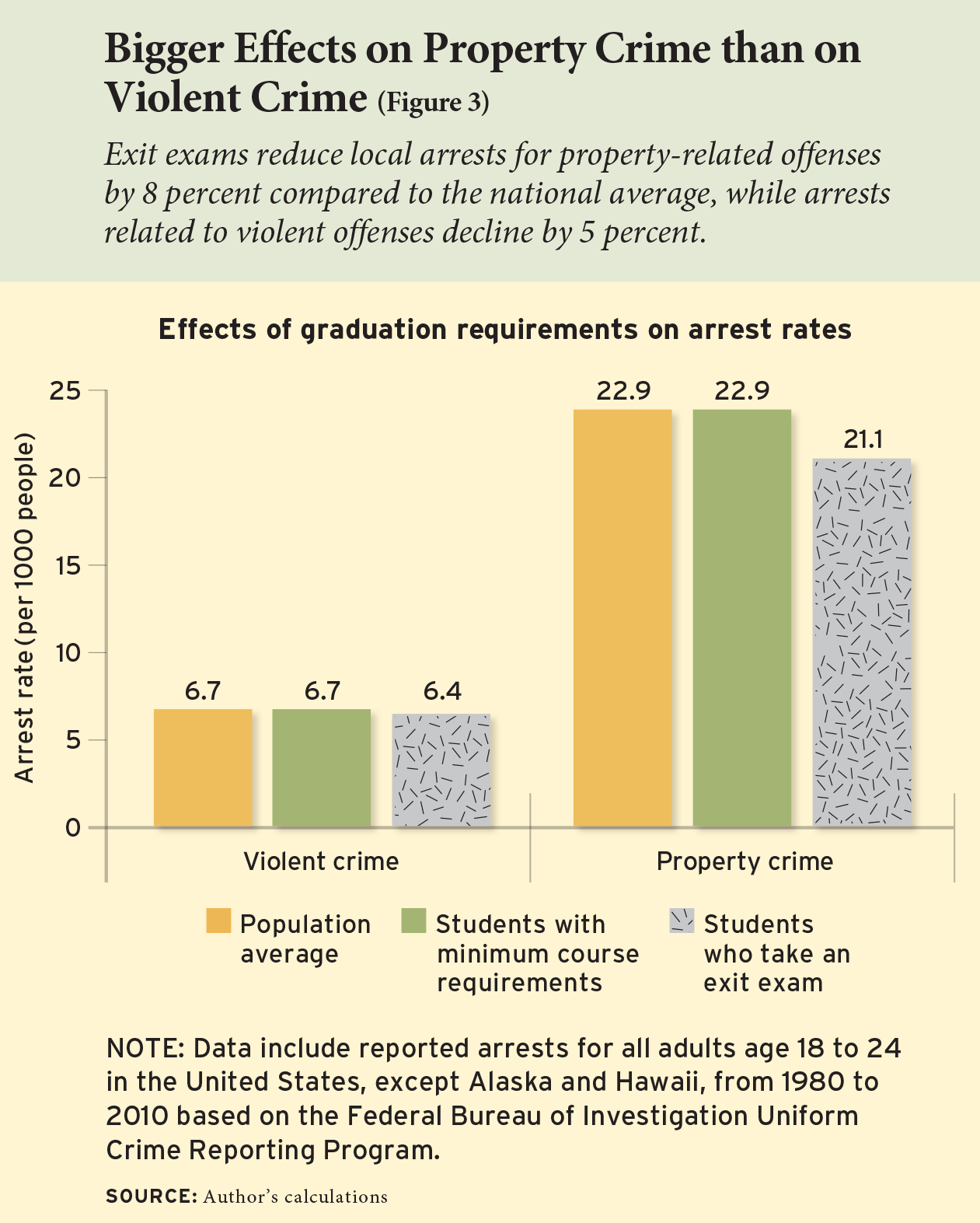 High-school exit exams have fallen out of favor in recent years, after research showed that pinning graduation to passing a high-stakes test can push some students to drop out. The future can be grim without a diploma: dropouts have higher rates of unemployment, earn far less money on the job, have poorer physical and mental health, and are more likely to be incarcerated. Wary of such risks, 18 states have dropped exit exams from their diploma requirements in the past two decades. This year, graduation requirements in just 11 states include an exit exam.
High-school exit exams have fallen out of favor in recent years, after research showed that pinning graduation to passing a high-stakes test can push some students to drop out. The future can be grim without a diploma: dropouts have higher rates of unemployment, earn far less money on the job, have poorer physical and mental health, and are more likely to be incarcerated. Wary of such risks, 18 states have dropped exit exams from their diploma requirements in the past two decades. This year, graduation requirements in just 11 states include an exit exam.
Beyond high-school dropout and graduation rates, exit exams might have other effects on students and communities. Little is known, for example, about the specific effects of exit exams on crime. Conventional belief holds that more and better-quality education reduces crime. Could exit exams improve teaching and learning in high schools such that criminal activity drops?
I looked at the arrest rates of jurisdictions and compared them during periods before and after graduation requirements were made more demanding in two ways: adding high-school exit exams and increasing the amount of academic coursework. I find that requiring exit exams decreases arrests by approximately 7 percent, primarily from a decrease in property crimes. Increasing course requirements, however, has no significant effects. My analysis supports earlier research regarding the beneficial effects of exit-exam use and is also one of the few studies to show that specific education policies can have crime-reducing effects.
Many states have temporarily suspended standardized testing, including exit exams, as part of ongoing school closures due to the Covid-19 pandemic. As decision-makers consider reinstating tests, these findings may be of particular relevance. While exit exams have come under fire for pushing students at the margins out of high school, my analysis indicates that they have more broadly positive effects on communities than previously understood.
The Rise and Fall of Exit Exams
For decades, educators and policymakers have been trying to make high school more rigorous, including by adding required coursework and introducing exit exams. The moves came after dire warnings that American public schools were failing to prepare students for college or the workplace, because classes were out of date and standards didn’t line up with employers’ expectations.
In 1983, A Nation at Risk, a report commissioned by the U.S. Department of Education, warned that the education system in the United States was failing to prepare students for the future. The report provided several suggestions for improvements, including all students taking four years of English, three years each of mathematics, science, and social studies, and one half-year of computer science. In response, many states increased their course requirements, resulting in a string of reforms from 1983 to 1986. A second wave of curriculum changes occurred in the mid- to late-1990s, as the importance of “rigor” took root in the nation’s statehouses.
During those decades, states also introduced new exit exams, or standardized tests that students must pass to receive their diplomas, inspired in part by the European model (see “A Steeper, Better Road to Graduation,” feature, Winter 2001). Across states, the new tests varied in difficulty, the subjects covered, and number of attempts allowed. In most cases, they covered material that students should have mastered between the 8th and 10th grades. When the 2001 No Child Left Behind Act required states give high-school students at least one exam in math and reading, many chose to make this a graduation requirement, and the number of exit exams grew rapidly, reaching more than half of all U.S. states (see Figure 1).

In theory, the presence of an exit exam focuses instruction on what the state deems important and guarantees that each graduate leaves high school with at least that minimum knowledge. And some research has shown positive effects: exit exams improve wages, employment, and college attendance. However, research also has shown that exit exams may prevent marginal students from graduating. And in general, high-stakes tests can create incentives for schools to prioritize tested materials and subjects—otherwise known as “teaching to the test.”
The tests have always caused controversy, as districts face the prospect of withholding diplomas from students who completed all other graduation requirements. That controversy grew more intense in this decade amid a general backlash against standardized testing in American schools. Many states introduced alternative assessments and other reviews that allowed students who did not pass exit exams to receive their diplomas. Others moved to strip exams of their status as a graduation requirement altogether. The number of states that require exit exams has consistently declined in recent years.
While much has been written about the educational effects of changing high-school graduation requirements, the literature is sparse when it comes to its effects on crime. There is a body of research detailing the connection between the highest level of education completed and a person’s subsequent rate of criminality—for example, a 2009 report found that nearly one in 10 males under the age of 25 without a high-school diploma was incarcerated on any given day, compared to one in 33 of their more educated young male peers. In addition, adults without a high-school diploma are nearly twice as likely to be unemployed as adult Americans overall, which a large body of research has shown is associated with higher rates of crime. A 2013 study by Olesya Baker and Kevin Lang examined the impact of exit exams on incarceration based on Census data, finding positive but mostly insignificant effects.
I pursue a more detailed investigation using yearly arrest rates, which can reveal the immediate effects of an exit-exam requirement, rather than later-life incarceration rates. These are important differences, as effects could fade over time or differ based on age and not all arrests lead to incarcerations long enough to be observed in Census data. My findings invite us to ask new questions about the value of exit exams.
Data and Method
I look at annual arrest data from the Federal Bureau of Investigation’s Uniform Crime Reporting Program, which is the primary source for crime statistics in the United States. Program statistics are voluntarily reported by nearly 18,000 police departments nationwide, including cities, universities and colleges, counties, states, tribal lands, and federal law-enforcement agencies. In all, my sample includes 14,888 unique police agencies across 48 states (Alaska and Hawaii are excluded). I limit my analysis to the annual arrest counts for men and women age 15 to 24 from 1980 to 2010, which results in a total of 2,627,438 observations.
The data are reported as aggregate counts of arrests by age, gender, and offense at each agency, by year. I make two assumptions: that the state where an arrest occurred is the state where the person attended high school and that their graduation year would have been the year in which they turned 18. The data include the number of arrests but not the total number of crimes or offenses committed.
While the arrest data are given as the total number of arrests, a more informative measure is the arrest rate, which accounts for population size. Since agencies are not a commonly measured geographical area, the data contain an estimate of the total population within the jurisdiction of each police agency. Unfortunately, these population estimates are not age-specific, so I use federal data from the National Institutes of Health to estimate age- and gender-specific population estimates in each agency’s jurisdiction.
I consulted a variety of sources to determine state requirements. For example, the minimum number of classes a graduation cohort would need to pass to earn a diploma is based on reports by the Education Commission of the States and National Center for Education Statistics. Exit-exam information is based on information published by the Center for Education Policy, among other sources.
To estimate the effects of expanding coursework requirements and adding exit exams, I compare the arrest rates of graduation cohorts who were educated in the same state at different times. For example, consider a state that introduced an exit exam for students expected to graduate in 2005. When examining the 2008 arrest data for jurisdictions in that state, I compare the arrest rates of young people age 21 and under, who were subject to the exit exam requirement, to those age 22 to 24, who were not. By focusing on the arrest rates of different graduation cohorts in the same year, I eliminate the influence of other factors that vary over time and are known to influence arrest rates, such as the number of police officers a jurisdiction employs.
When making these comparisons, I control for the economic conditions in the jurisdiction when each graduation cohort was in high school. I also control for several characteristics of each state’s school system when the cohorts were in high school, such as the average pupil-to-teacher ratio, teacher salary, and per-pupil expenditures. I assume that, after making these adjustments, the only major difference between students from different graduation cohorts is that one group faced tougher graduation requirements.

Effects of Exit Exams
When states expand the coursework required to earn a diploma, there is no significant effect on arrests. But when they mandate high-school exit exams, arrest rates fall.
Students who face an exit exam have 2.2 fewer arrests per 1,000 individuals than those without any exit exams—approximately a 7 percent reduction from the local average (see Figure 2). This effect may be initially surprising given the increased dropout rates associated with exit exams found in prior research. However, exit exams may have far-reaching effects beyond those for the marginal students who are induced to drop out. For example, exams may help refocus the curriculum, build noncognitive skills, and potentially affect the labor-market value of a diploma.
I find different effects on arrests based on the types of alleged offenses: there is an 8 percent reduction in arrests for property crimes and a 5 percent reduction in arrests for violent crime (see Figure 3). In looking at coursework requirements, I find no strong effects on any offense type.
These results are in line with what we might suppose are the theoretical effects of exit exams, as well as previous research. If much of the effect is driven through an increase in income due to higher wages or likelihood of employment, for example, then it is reasonable to believe that crimes with monetary gains such as burglary, larceny, robbery, and auto theft would be most affected. If there are noncognitive mechanisms at work, then one might also expect changes in non-monetary crimes like murder, rape, or assault—which I find in these results. While it may be surprising to see effects on violent crime, prior research by Lance Lochner and Enrico Moretti found statistically significant reductions in violent crime due to increased education.

Impacts by Race and Income
I then look at which groups and community types are most affected by the presence of a high-school exit exam. Prior research on graduation requirements and academic outcomes has found a negative impact for African American and low-income students. Studies by Thomas Dee and Brian Jacob and by Steven Hemelt and Dave Marcotte found black students are more likely to drop out after schools require exit exams, for example, and a study by John Papay, Richard Murnane, and John Willet found exit exams made it more likely that low-income students would not graduate. However, other curriculum reforms are associated with positive effects for these groups; for example, Joshua Goodman found that in states where more math classes were required, African American students earned higher wages in adulthood.
For income, I find that for both types of graduation requirements (that is, the presence of exit exams and required courses for graduation), counties with the lowest average incomes appear to see the largest crime reductions. In particular, results for exit exams are large and statistically significant for the poorest counties, while results for counties in all other income quartiles are not significantly different from zero or each other.
The patterns with respect to the racial composition are quite different: Exit exams exhibit significant and large crime-reducing effects for the two quartiles of counties with the highest percentage of white residents, while the effects for the bottom two quartiles are smaller and statistically insignificant.
I also find that both rural and urban counties exhibit large crime reductions due to exit exam requirements, with no statistically significant effects in counties that are within large metro areas but suburban in character.
These results provide some insight into how these effects might occur. If exit exams are helpful in that they cause more advantaged students to increase their skills and knowledge and therefore commit fewer offenses, while simultaneously causing more vulnerable students to drop out of school in greater numbers and commit more offenses, we would expect to see less encouraging findings among populations where the dropout effect is largest. Based on the prior literature, that would be among non-white, low-income, and urban students, which is largely what my analysis finds. One exception to this explanation is the finding that the largest reductions in crime occur in the poorest counties. However, a potential reason for this finding is that those counties have the most crime before the reforms take effect. Perhaps other counties do not have as much crime to begin with, so it is more difficult to see large arrest-reducing effects in those cases.
From a policy perspective, it’s important to note that these results show no significant increases in arrests for any of the subgroups examined and are largest in low-income counties, which are often those most in need of crime reduction. However, the effects differ in counties whose populations are predominately white or predominately minority; arrest rates fall more in largely white counties than in counties with larger proportions of minorities. This suggests that these policies may widen already large gaps in arrest rates between white and minority residents, which could increase inequality in other dimensions.
A Complex Calculation
Taxpayers and voters often tout slogans such as “build schools, not prisons” based on the common belief that education can deter crime. Indeed, my analysis shows that specific education policies, such as requiring high-school students to pass an exit exam to graduate, lead to lower rates of arrest.
The question is, how? I see a few possibilities. The increased accountability of an exit exam could motivate schools and students to increase learning, or the effort needed to pass the exam could also support students’ developing better noncognitive skills. It also could boost the perceived value of a high-school diploma. Or, students could choose to attend school more often, because they know they will need to prepare for and pass the exam in order to graduate.
Yet exit exams have been subject to widespread skepticism in the public discourse, including criticisms that they are punitive and exclude too many low-income students of color from earning their diplomas. The findings of this analysis provide evidence in favor of their use. The accountability and rigor that exit exams impose appear to have farther-reaching benefits throughout communities than previously assumed.
It is important to realize that these benefits are an average effect, however, and that exit exams may not be helpful to every student. Indeed, some students on the margin of graduating could be forced to drop out. In addition, I find evidence that exit exams may be more beneficial for white students than minority students, which may work to increase already large racial gaps in arrests. Though there is also evidence that the effects benefit lowest income counties the most, which could help the areas most in need of crime reduction.
While the explicit goal of educational reforms is not to reduce crime, it is certainly a positive result. Public education is intended to prepare students with skills and knowledge they need to participate fully in their adult lives, including working, voting, and maintaining healthy communities. Surely decreased rates of arrest among young people are an important component of that overall goal. Raising the rigor of a high-school education, so long as students who may be left behind are given the support they need to succeed, can promote public safety as well as purposeful adult lives.
Matthew F. Larsen is an assistant professor at Lafayette University.
This article appeared in the Summer 2020 issue of Education Next. Suggested citation format:
Larsen, M.F. (2020). High-School Exit Exams are Tough on Crime: Fewer arrests where diplomas require a test. Education Next, 20(3), 60-65.


